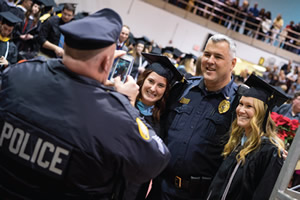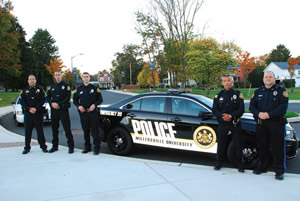Keeping Them Safe
- By Brandon Barrett
- 12/01/15

PHOTOS © MILLERSVILLE UNIVERSITY
Safety on campus takes many forms, and has many aims — from ensuring students are secure in their dorms to dealing with potential active-shooter incidents. The technologies, tools and strategies to achieve campus safety are almost as varied as the tasks they must carry out and the situations they plan for. One question should always be asked, especially when dealing with student safety on campus: what works best?
With this question in mind, College Planning & Management asked some of the top-rated campus police departments in the country what is working for them. While no one product or technology will counter every security threat your campus might face, it is good to know what the best in the business are using to keep things safe and secure.
At Arkansas State University in Jonesboro, Chief Randy Martin and his department rely on several technologies to keep students safe, and facilities and grounds secure. For Martin, strategy comes first, before any new technical tool or initiative to achieve safety goals. “I feel the greatest initiative we have is persistence,” he says. “We have a young population that is transitioning to the independent lifestyle of a university campus.
We have a small window of opportunity to develop them to be mindful of their safety. We spend considerable time with training to all campus community members. We also meet at least once a month with the Student Government Association to get student perspectives of safety issues and concerns.”
There’s an App for That
While persistence and proper education are key, departments like Arkansas State University Police and also the Millersville University Police in Millersville, PA, rely on a host of tools. “Our most critical safety technologies are cameras, card access, emergency 911 (blue) phones, mass notification system and our new safety app LiveSafe,” notes Chief Peter Anders. He also adds that tools like card readers can reduce investigative times for incidents, and make quality-of-life improvements for students across the campus.
Some of the apps and technologies that have been making waves in campus safety are those that both monitor suspicious behavior at academic or social events, or allow students to report suspicious behavior anonymously.
For notification and tip reporting, for instance, Arkansas State University has adopted a smartphone app, which lets community members connect and report anonymously. “The use of an application for smartphones, called ‘Quiktip,’ has been helpful for our community. The app allows the community to provide text messages and photos directly to the police communications center,” explains Martin.

PHOTOS © MILLERSVILLE UNIVERSITY
WHO YOU GONNA TEXT? Campus police departments, such as the Millersville University Police in Millersville, PA, are seeing good results with apps that enable campus community members to submit incident alerts and detailed tips, complete with GPS coordinates, detailed physical descriptions and even photos of potential lawbreakers or license plates. The new apps are catching on partly because students feel more comfortable with texting or communicating through their phones or other devices instead of calling, which may be intimidating.
What makes the app particularly useful is the ability for those using it to remain totally anonymous. “The anonymous feature of the app has been well received by our community, and has been frequently used to report safety and behavior concerns that would potentially not be made known to campus officials,” Martin confirms. This demonstrates the importance of making those in the community feel safe when providing information that will lead to stronger campus security.
Likewise, at Millersville (MU), Chief Anders emphasizes the importance of having a student-centered safety app in maintaining a safe place to live and learn. “MU Police have committed to mapping major and serial crimes on the campus map which students are able to access from our safety app,” he notes.
The app, which relies on student input, contains not only information about current and potential threats, but also acts as a library of important campus safety information. “We have added campus and county evacuation routes to the app, and other resources such as mapping blue phone and AED locations, sexual assault and Title IX resources. We continue to modify the app based on student feedback,” explains Anders. “Our students have been extremely engaged with our safety app.”
Other apps, like Social Sentinel, act as databases for information and monitoring tools for suspicious behavior or activity at campus events. The app monitors social media accounts and patterns and has search engine functionality that allows authorities to search for certain keywords that are related to on-campus threats. There are limitations to the app, such as social media profiles with privacy restrictions turned on, but it can still serve as an invaluable tool, especially for police forces on larger campuses.
Keeping Track of Campus and Community
At the University of Cincinnati in Ohio, a sprawling campus located in the heart of the city, fighting crime relies on using data and the Internet as a tool for students and police alike. The university keeps an active crime log on their website, which is able to track incidents and serve as a database of crimes and issues that have arisen across campus. “The university tracks crimes in several ways. First, we track and report all Clery reportable crimes, which are published in our annual Security and Fire Safety Report,” explains Director of Public Safety Jim Whalen. “This report is available on our website. We keep a crime log, which tracks all reported incidents and additionally, Incident Reports are published on our website.”
Having such a readily updated record of incidents allows students to search by incident, address or even to view current safety conditions on campus in real-time. Giving students, parents and all other campus community members this information can impact everything from making daily plans to setting up living arrangements for the upcoming academic year. Technological efforts such as Internet alerts, the web crime log and enhanced street lighting and officer presence have led to a 10-year low in crime on Cincinnati’s Uptown Campus, notes Whalen.
Another safety-centered technological advancement, which has become critical recently, is the use of body cameras for police forces, whether campus or otherwise. On a college campus, where things can sometimes unfold quickly, Chief Martin acknowledges that the cameras do help greatly in various situations. “We do have body cameras for all of our patrol officers. Our officers were very receptive to them, and they have been an asset to our operation. The cameras are helpful for the officer, community member and prosecution,” he says, noting that it is best to use them as a tool, but not necessarily as a complete representation of the facts of any situation.
At Millersville, current Pennsylvania state law has kept the police from utilizing body cameras, but that doesn’t keep Chief Anders from speculating about how useful they may become in the future. “I believe body cameras are a great tool for law enforcement; video evidence is valuable and I believe there is value to holding our officers and the community to high levels of professionalism and civility,” he explains. The chief adds, “We [the campus police] are public servants. I believe in community policing at our core. I see this as simply another tool on our tool belt.”
In the end, according to Martin, a campus police force is only as strong as the training its members are provided with. Training and technology must always work together to create a safe environment. “Focus on training. University police officers may not always deal with the same issues as frequently as municipal or county agencies, however, when they are presented with an issue the magnification of the incident is much greater in a university setting,” he stresses.
Chief Anders also stresses that the role of campus police chief is one that relies on being in tune with your community and officers, ultimately. “[The advice I would give other campus police chiefs is] the same advice as I would give to municipal leaders; stay in tune with your officers — they want a leader who communicates with them personally rather than with memos and emails, and make daily efforts to connect with the community you serve.”
While technological strides are making campus policing more efficient, and complete safety a more realistic goal, training and a sense of community are still important. As new technologies continue to surface, campus police will find new ways to keep their colleges and universities safe, all while keeping community policing and public service at the forefront.
This article originally appeared in the issue of .